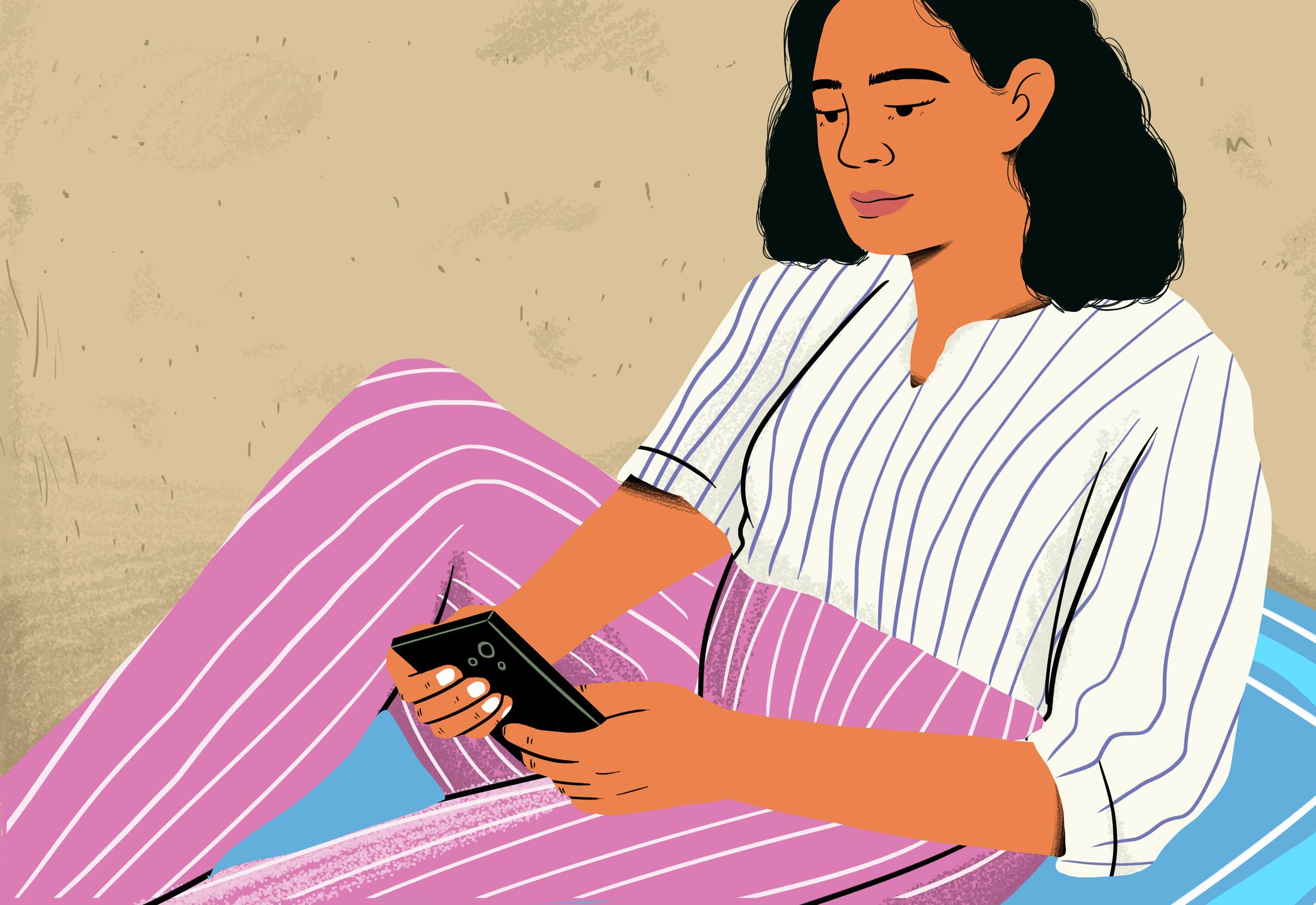
When you think of the term “Instagram stalking,” what kind of scenarios come to mind? Is it vetting an upcoming Hinge date’s profile to ensure they tick all the critical boxes: they have friends, they like to travel and they look the same in their tagged photos as they do the ones on their profile? Is it to suss out whether a couple has broken up? Is it being sucked into a black hole of scrutinising the fashion (and lifestyle) choices of your high school arch nemesis?
As evidenced above, when we imagine ourselves digital sleuthing, it always involves other people. But look inward, and you might realise that you — yes you — are your own most dedicated viewer. For many on TikTok, it’s common practice: we share an Instagram story – a supposed 24-hour-only glimpse into our lives – and we find ourselves in a deadly cycle of replaying it and monitoring the viewer list. While the latter exists for a reason (allowing us the privilege of knowing if that person who we wanted to see the story, saw it), what is it that drives us to watch our content back? It’s not like we’ll find anything new – we’re the ones who published it, after all.
This behaviour isn’t limited to stories, either. I’ll admit it: sometimes when I’m feeling down, I’ve found myself looking back over my grid, pausing on holiday photos, snapshots from nights out, birthday celebrations, and sometimes, a selfie where I know I look great. I’m not the only one, either: while some flick through their social media profiles for a morale boost, others, like @xoxotatianaa on TikTok, state the facts: she watches her content repeatedly because she can, and she doesn’t care (and neither do the 667k others than agree with her).
So, why do we do it? Is it because we’re perfectionists, obsessed with our content fitting in with the digital version of ourselves we present to the world? Are we so hyper-aware of being perceived that we try to view ourselves through someone else’s eyes? Or are we just in love with ourselves?
“Say I get some new followers, I like to view my profile from the perspective of what they’re seeing…”
I posed the question to my own Instagram followers (via a story which, yes, I watched back a few times). “Say I get some new followers, I like to view my profile from the perspective of what they’re seeing, even if I know what my profile looks like,” one friend, Tom replied. “When someone follows me, I wonder what they’re looking at, so I check through it to see what they see.” Another friend, Kat, said: “I pretend I’m someone else because I want to see how other people perceive me and if they’d think I have a cool grid (I just cringed typing that out).”
Seeing ourselves from other people’s POV
According to Eloise Skinner, a psychotherapist and author specialising in existential identity, there are several factors as to why we stalk ourselves – one being a desire to see ourselves from an external perspective (think Ariana Grande’s song POV). “The desire to understand how we’re perceived has been present in human instinct for generations,” she explains. “As we try to understand ourselves – answering the timeless question of ‘who am I?’ – we often draw on the opinions and reflections of others to guide us.” She continues that when we don’t have that information handy, we take it upon ourselves to decipher the thoughts and opinions of others by imagining what they might see when they look at our profiles.
Psychologist Zoe Mallet agrees, and says that evolution has shaped our innate desire for social acceptance and status, ingraining a “deep-seated need for social approval” into our being. “The tendency to present oneself favourably is a direct offshoot of this, online and offline,” she says. “It’s a subconscious attempt to enhance our social standing, increase our chances of belonging and create a positive self-image, which is part of our survival coping mechanisms as humans.”
“The desire to understand how we’re perceived has been present in human instinct for generations.”
Both Skinner and Mallet note that our attempts to control how we’re perceived existed long before the arrival of Instagram – like how we spend time picking out an outfit for an event, or what we say in a conversation with an acquaintance. Social media, then, has become a digital platform to project this onto – it’s an attempt to reflect the identity we want people to perceive us as embodying. Although it may seem like stalking ourselves is the best way of ensuring that we keep this identity in check, Skinner points out that for some, self-stalking is rooted in perfectionism.
Take journalist and content creator Mared Perry, for example, who tells me that she watches her stories repeatedly for two reasons. The first is to make sure “content looks slick” in case of potential work opportunities, and secondly “because of the paranoia that other people may find something cringe, or that I’m oversharing”. “Self-stalking could stem from a feeling of insecurity about our sense of identity, how we appear to others, or even a critical feeling about what we post and where we should improve,” Skinner continues. “There’s a greater awareness of how we compare to others online – in other words, it’s easier to hold up our digital lives against someone else’s, to see what we like or don’t like.”
How am I presenting myself online?
It’s important to remember that not everyone uses social media in the same way. Some use it to maintain relationships and stay connected (“If this is the case, it might seem less important to present in a certain way,” Skinner says), whereas for others, like Perry and journalist David Chipakupaku, it’s deeper than that – it’s an extension of who they are. “I want to show all the different facets of who I am on my social media, and I don’t want to be known for just one thing,” Chipakupaku tells me. “I’ll share the different sides of myself – I’ll post a meme and I’ll share news posts. It’s about getting the balance right. Am I being too funny? Too serious? Too weird? Too much?”
He says that he’ll check his content over and over again due to a mix of “anxiety and sense-curating”. “When someone taps on my story, are they going to come away with a full understanding of who I am? If yes, I’ve done it right. If not, I’ll add something or take it away. It sounds so insidious and weird, but it’s true.” Mallet points out that this phenomenon is unique only to social media. “Think about how we show up in real life – there are limits to how many sides of ourselves we can show per situation or experience. We can’t go back and curate it. But online you can, which adds to this mounting pressure of wanting to present as perfect,” she says. Skinner adds that while this pressure could be internal (the same impulse that makes us reflect on how we presented ourselves at a work event, for example), it can also be external: “For instance, the demands we put on ourselves to have a certain image, following or level of popularity on social media.”
There’s a host of reasons why we trawl back through our content (so it’s not just because we’re in love with ourselves, which isn’t always a bad thing). But does a distinction exist between this behaviour being normal and unhealthy? As of September 2024, Instagram has 2 billion active users globally, all of whom produce a lot of content. Skinner believes It’s pretty normal, then, that we’d want to look back over our content from time to time, like how we’d flick through a photo album, journal or scrapbook. “Social media can act as a storage unit for older versions of ourselves and our identities, so reflecting with appreciation, nostalgia or thoughtfulness can be a supportive, beneficial activity.”
The signs to spot when we might be going too far? Other than if it’s taking focus away from other important parts of our lives, Skinner urges us to be aware of how the act of self-stalking makes us feel, in the moment and afterwards. If we find it motivating or comforting, great. But it also risks making us more critical of ourselves or leaving us wrapped up in the past. “If it makes us more self-conscious, self-absorbed or distracted from whatever we’d like to use social media for, it’s worth rethinking the habit,” she advises.
Last year, research from Bournemouth University found that young adults who use social media passively (by browsing the content of others) are more likely to experience mental health problems such as anxiety and depression than those who share their own content (active users). Self-stalking puts a spanner in the works, though: we’ve posted this content ourselves, but we’re now the ones viewing it passively, too. While research into self-stalking doesn’t exist (yet), Mallet urges us to remember that from the start, social media was designed to be addictive. “When we post, we’re validated by the responses we receive and get a hit of dopamine. We want that hit again and again, so of course we’ll head back to the source where we experienced it before,” she says. “It’s not that we’re addicted to looking at our own Instagram. We’re addicted to the feeling we get when we do.”






















0 Comments